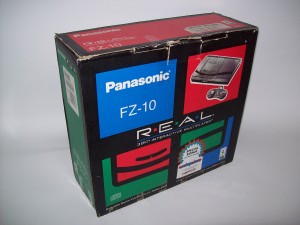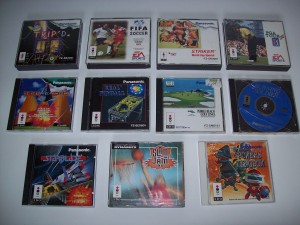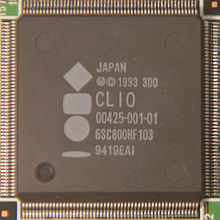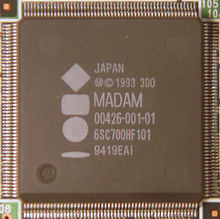 The Panasonic 3DO FZ-10 interactive multiplayer was a 32-bit CD based interactive video entertainment platform system. To many it is simply known as just the 3DO and it arrived to us on 15th September 1993.
The Panasonic 3DO FZ-10 interactive multiplayer was a 32-bit CD based interactive video entertainment platform system. To many it is simply known as just the 3DO and it arrived to us on 15th September 1993.
The 3DO Company was founded by a group of people in 1991, namely Dave Needle & R.J. Mical of the New Technology Group although the 3DO was conceived by entrepreneur and Electronic Arts founder Trip Hawkins.
Unfortunately the Panasonic 3DO never got of to a great start. The machine had been priced at $699 which was higher than any other console of it’s time. The reason for this being was that the 3DO was being sold as a high-end audio-video interactive system and not just another games console. Also in the early 1990’s the market for consoles was saturated, so the 3DO was up against stiff competition such as the likes of the Sega Genisis (priced at $149), Nintendo’s – SNES (priced at $199), NEC’s – TurboGrafx-16, Nintendo, Commodore and SNK.
A few differevt versions of the 3DO were created. The Panasonic version was released with ‘Dragons Lair’, a classic laserdisc game that was first released in the arcades. A multi-changer version was also created called the Panasonic Robo 5 disc changer.
Sanyo released their version with a game called ‘Myst’ a game that I really got in to. Last of all ‘Goldstar’ released their version which came with a violent road racing game that really showed off the 3DO’s capabilities ‘Crash and Burn’ another great classic. Even a Samsung version was briefly known to make an appearance.

In 1996 the price of the Panasonic 3DO was to be dropped due to the new arrival of the 3Do’s promised successor, the ‘M2’. This was to be a more powerful console using a dual PowerPC 602 processor in addition to newer 3D and rendering Technologies. Major promotional efforts were made for the M2 but despite this the ‘M2 Project was rumoured to have been scrapped but it was also believed to have been sold to ‘Matsushita’.
Later in 1996 the plug was pulled on the 3DO along with a complete shutdown of all internal hardware development and of the ‘M2 Technology’. 3DO restructured themselves around this time, repositioning of their internal software development house as a multi-platform company supporting the Sony’s Playstation, Sega Saturn and PC platforms.
I believe that the Panasonic 3DO had a library of some 237 software titles. Some of the games to be released i though were quite Excellent. Some of the games were ports of arcade or pc games that other cartridge-based systems of it’s time were not capable of playing. I personally still like such titles like Myst, Crash and Burn, Need for Speed, Gex, Alone in the Dark, Road Rash and Star Wars: Rebel Assault.
I do however have mixed feeling about the 3DO as i was never an outstanding console but it was never a bad one either. The Panasonic 3DO will always have it’s place in the hall of fame for consoles but i firmly believe that due to the way of market at the time, if the Panasonic 3DO would have been released that bit earlier it really would have been a sure winner.
Here is a advertisement clip for the Panasonic 3DO. Enjoy. . .
One thing is for sure. I will still have a blast on the old 3Do for years to come.
Technical specifications
Processor
- 32-bit 12.5 MHz RISC CPU (ARM60)
- Custom Math co-processor (It does not use the stock ARM FPA unit.)
- 32kb SRAM
Panasonic FZ-1 “Clio” graphics accelerator
Display
- Resolution 640×480 (interpolated), 320×240 (actual) 60 Hz for NTSC version, and 768×576 (interpolated), 384×288 (actual) 50 Hz for PAL version with either 16 bit palettized color (from 24 bits) or 24 bit truecolor.
- Two accelerated video co-processors capable of producing 9–16 million pixels per second (36–64 megapix/s interpolated), distorted, scaled, rotated and texture mapped.
System board
- 50 MB/s bus speed (synchronous 32-bit @12.5 MHz bus)
- 36 DMA channels
- 2 MB of main RAM
- 1 MB of VRAM
- 2 expansion ports
Sound
- 16-bit stereo sound
- 44.1 kHz sound sampling rate
- Supports Dolby Surround sound
- Custom 20-bit Digital signal processor (DSP) – 20 bit accumulator with 16-bit parameter registers for extended precision
Media
- Double-speed (depending on manufacturer) 300 kB/s data transfer CD-ROM drive with 32 kB RAM buffer
- Multitasking 32-bit operating system
Connectivity[edit]
Audio & Video[edit]
- RF Switch An RF connector can be used on older TVs that have no RCA jacks. The 3DO is compatible with NES, SNES, Sega Masters, Sega Genesis, & NEC Turbo Grafix RF switches. This provides the lowest video quality.
- Composite RCA The 3DO, just like the Amiga CD32, has standard composite video and audio (red/white/yellow RCA connector on both ends) ports that are compatible with off the shelf cables like the ones used on DVD players and other video devices.
- S-Video The 3DO has an S-Video port on the back for the best possible picture quality (not on the Goldstar GDO-101M model).

